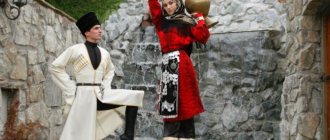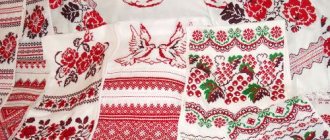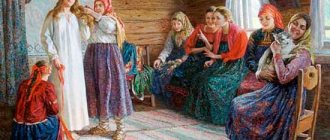The first lights in the village were lit, which means night is near. Yarina is restless in her soul, rushing around her upper room like an animal in a cage. And after all, any other girl in her place would go crazy with happiness, and would roll her eyes languidly. Today they will come to Yarina to get married, but she doesn’t know what to do. On the one hand, you look and Gorislav is dear to her. The first fellow in the village, broad in the shoulders, and with hair darker than a raven's wing. And the look, as if living amber was burning in it. It has its own forge, a bright and large house, and even cattle. All the village girls rush at such a groom, but Gorislav sees no one. He won't even smile once. He walks around all the time, gloomy and serious, never comes to the river for a get-together, doesn’t even jump over a fire. And he is older, and tall as a rock. Yarina was still just a girl, and Gorislava stayed away. As soon as he sees something in the distance, he goes and immediately runs and hides. And she would hide, so she started peeking. She liked to watch how Gorislav worked in his forge, how his hands were strong and dark, with fire, how he treated a small child. Yarina sat like a mouse, she was afraid to even breathe. And she also saw how this blacksmith smiled gloomily, so that it was as if the sun appeared from behind the clouds for a moment. He smiled only in his forge, as if he was afraid that someone would see. Gorislav sunk into the heart of little Yarina, and when she reached her sixteenth spring, the blacksmith found her hiding place. How ashamed she was then, Yarina had never blushed so much. And the blacksmith, you know, looked at her with his amber eyes and smiled. He told her to go home and no longer sneak up like a thief, but come like a welcome guest. From then on, it became a habit that Yarina would run away from her mother and go straight to the forge. He sits in the corner and is silent the whole evening. He watches how the fire in the furnace dances, how the hammer falls heavily on the hot iron. Gorislav stealthily looks at his guest and smiles in his thoughts. Curious Yarina, headstrong, with a completely unyielding disposition, but so kind and sincere that it is impossible not to love her. So Gorislav fell in love with her, and said that he would come to marry her. I'm restless because of something in my soul. And she is waiting for her betrothed, and she is afraid that he will come. Mother said that all the girls are worried about this, they are afraid to leave their father’s house. Yes, but if Yarina is scared, what if Gorislav turns out to be harsh and starts forbidding her from everything, for example, dancing or laughing. The married girls, all of them sitting gloomily at home, and not singing at all. Yarina doesn’t want this kind of life.
She heard them enter the upper room. So the matchmaking has begun. And Gorislav came not alone, but as faithful friends. He hears his father asking the blacksmith about everything. Yarina almost doesn’t breathe, she knows that her father liked such a groom. But she can’t sit still, so she bursts into the room like crazy without permission. She doesn’t see anyone except Gorislav, and he stands spellbound and only looks at her. Suddenly, she takes off from her place, and embraces her little one in his big arms and says:
- Don't be afraid of anything, dear. I will love you with all my soul. I will die for you and I will live for you. You will live with me as a free bird. You won’t, like your married friends, walk around gloomy and unfriendly. You will sing so that your voice will sound clear in my house. I want you to smile and laugh like a little child, carefree.
Yarina listens to Gorislav’s quiet voice, the beating of his heart, and all her worries go away. She has nothing to fear now with such a groom. He loves her, and she loves him. Just let the priest schedule the wedding as soon as possible, so that the whole village can walk around, drink hops and dance in circles. Yarina wants others to be happy too. And I thought it would be better if Gorislav came to her during the day to woo her, so that everyone could see what an enviable husband she would now have. It’s not good for someone like that to come at night and in the dark, because no one will refuse such a groom.
Wedding traditions and rituals of the ancient Slavs
The ancient name of the wedding is Lubomir .
This day was celebrated without alcohol, fights, drunkenness and other indecent behavior. Lubomir is, first of all, a celebration of the soul, and only then of the body. A richly laid table was a secondary task. The tradition of wedding rings is an ancient and complex ritual. They have been preparing for engagement since adolescence. When a boy or girl turned twelve years old, they began to wear a silver ring. It was believed that this metal was sacred and capable of absorbing the positive energy of the owner. At the moment of engagement, the bride and groom exchanged these rings. They had to be worn closer to the heart - on the neck.
With these rings, the couple had to spend from 16 to 40 days, soaking in each other’s energy.
The newlyweds received the blessing of their parents; without it, the betrothal was considered invalid.
On the wedding day, the bride and groom put other rings on each other's ring fingers of their right hands. Silver ones were returned to the owner and worn on the ring finger of the left hand. This ritual closed the spiritual circle between the newlyweds.
There was no ransom in a Slavic wedding . This is due to the fact that the holiday is spiritual, there could be no talk of any money. On the eve of the wedding, fights were organized between the groom and the male relatives of the bride (father and brothers). This demonstrated the ability of the future spouse to protect his family. Another test option is hunting. The groom showed the bride's father how lucky and dexterous he was in this craft.
The bride had to undergo tests conducted by the female half of the groom. A woman was valued for her knowledge and skills in needlework, cooking, housekeeping, and it is good (but not necessary) for her to be able to sing and dance.
An obligatory part of the wedding day is round dances . The wedding round dance was especially important. It was held at the end of the celebration. Young people came closer to the reservoir and lit two fires on the shore: one for the boys, the other for the girls. The women's round dance was always performed in the direction of the sun; it was called posolon. The male round dance is in the opposite direction, that is, anti-salt.
Post wedding rituals
After the wedding, their own rituals were carried out. On Monday morning, after the wedding night, it was customary to hang the bride’s shirt on the porch, on which there were supposed to be traces of viburnum, that is, blood (something smacks of the TV series “Clone”, where this shirt was generally dragged all over the city, screaming and dancing) . In honor of this, the mother of the groom presented her now daughter-in-law with an elegant scarf and a red belt, which was a symbol of a married woman.
A month later, after Lyubomir, in order to help the new housewife get comfortable in someone else’s house, a new feast was organized, where families and relatives of the newlyweds gathered. Such a feast was called Kalachins, because on this day it was customary to give each other rolls. Such a feast could be held both in the groom's house and in the bride's house.
The time for holding Lubomir was usually chosen in the spring or early summer. But still, the decisive factor here was the type of action of the bride and groom. For example, it was easier and more convenient for warriors to organize a celebration after completing a military tour and participating in battle. Farmers had a wedding after harvesting. That is, the time was chosen when families had good income to hold a wedding ceremony, because it required considerable expenses. For example, before the wedding itself, there was a tradition of giving gifts to all loved ones, and this was done more than once. The gifts themselves were prepared by the mothers of the young. These were mainly scarves, belts, rag dolls, small change, etc. This action emphasized the readiness of the girl and the boy to create a new family that would be independent and wealthy. But it also meant a kind of invitation to a new family circle, and a trust. All major costs were borne by the families of the future spouses. Gifts from guests were not assessed as an opportunity to offset expenses. On the contrary, when a guest’s gift was assessed, the bride and groom certainly had to give this guest a more expensive gift. This emphasized the principle of “our people”, who were not usually counted.
In conclusion, the author would like to say to all readers - if you love, then love with all your heart and without doubt. It doesn’t matter who you are or where you come from, you and I may have different roofs over our heads, and different words in our heads, but love is inevitably the same for everyone. Believe what your soul believes in, do not set limits for yourself, think, but with your heart, and then you will find your path along which you will walk hand in hand with your soul mate. Love and prosper my dears!
Photo
Here you can see a photo of a Slavic wedding.
Modern wedding rituals
What now? Customs that have lost their meaning. Rituals at a wedding blindly copy some individual actions. Yes, the bride is in white, but the dress, inappropriate for the event, reveals her arms and shoulders, and there is no thick veil. It reveals itself just at the moment when it needs to be covered. Rituals at a wedding involve drinking alcoholic beverages for fun, when, on the contrary, you need to be focused, sublime and careful. Those accompanying the wedding believe that they were invited as witnesses to the event, instead of recognizing themselves as protectors for a dangerous time. As before, cars with young people try to drive across the bridge and go to the fire, having forgotten the reason for what is happening. The splash of water evokes some forgotten feelings, of course. The eternal flame, lit in almost every city for a completely different reason, attracts young people with some kind of genetic memory.
Will our society return to understanding true causes and effects? Will we be able to remember, realize, and not be afraid to become different from the crowd? Will we be able to be born, have a wedding and die correctly? These senseless and dangerous weddings will, of course, continue. But there is hope that some of us can get it right. For those who are open to the living heritage of the past.
Book of Ancient Knowledge “Games Played by the Gods”
Stylistics, symbolism and attributes
In order for the wedding day to go according to tradition, the following attributes must be present::
- Rushnik . This is an embroidered piece of fabric in the shape of a long towel. It was the protection of the family and clan, it was passed on from one generation to another. The towel was used to present a loaf or other treat. It was forbidden to step on the towel, as the family would lose the protection of the spirits and doom itself and its descendants to misfortune.
- Homespun towel . It was used to bind the hands of young people during betrothal. Afterwards, the towel was given as a dowry to the bride.
- Loaf . Sweet bread beautifully decorated with curls, flowers, braids. The richer the loaf, the happier and more prosperous the life of the young people was. With the help of the loaf, a ritual of honor to Mother Earth and Father Sky was performed.
- Rings . With their shape they symbolized the sun, which was held in high esteem by the Slavs, then still pagans. The circle is a symbol of harmony, unity and fidelity.
- Wreath of flowers . It was worn by both the bride and groom. A wreath is a symbol of love and sun rays hidden in herbs and flowers.
- Wedding party . An embroidered amulet signifying both the creative and destructive principles of the sun. It means the interweaving of two families and serves as a talisman for a new family. The wedding dress was given by the parents after the wedding ceremony.
Wedding rituals. Should not be doing that!
This is what sacred wedding ceremonies look like today. Probably, something remains inside, with some almost forgotten feelings we understand that before our eyes a most important event is taking place, determining the fate of further children of this kind. But do these people know, does the bare-backed, bare-armed bride without a veil know what she is risking by going to her husband’s house in this form? I'm afraid not. A wedding in Slavic traditions is deep and meaningful.
The union of a man and a woman in a marriage is not just a matter for the two of them. At a higher level of being, this is a matter of two kinds. For the bride's family this is a loss, for the husband's family it is a gain. But this is at the same time, and strengthens both types. It’s not without reason that they say that as a result of a wedding, people become “RELATED” and acquire “new RELATIVES”.
How to organize such an event in the old Russian style these days?
Preparation is an important part of organizing a modern Slavic wedding:
- Place of celebration . It is better to choose a lawn, not far from a pond. Another option is a country house or estate in the Russian style.
- Invitations . These can be postcards with folk patterns, decorated with flowers and twigs.
- Menu . There should be dishes of Russian cuisine on the table. Their variety is enormous: cabbage soup, fish soup, pies, pancakes, stewed meat, baked fish, pickles, mushrooms, herring. Instead of a cake, it is better to serve a large berry pie.
- Alcohol . His presence at a Russian wedding is undesirable. If you cannot do without it, then it is better to give preference to Russian drinks: kvass, mead, herbal and berry tinctures.
- Cortege . The ideal option is horse-drawn carts. If this is not possible, then the cars can be decorated with ribbons with folk ornaments and wildflowers.
- The image of the bride . For a girl, it is better to choose a floor-length red sundress with a white, embroidered blouse. A more familiar option is a white wedding dress, trimmed with embroidery in a folk style. On the head is a scarf or a wreath of flowers. The traditional hairstyle is a braid.
- Image of the groom . Consists of trousers, white, embroidered shirt, wide belt and boots.
Wedding rituals - water and fire
The wedding ceremony includes the obligatory crossing of flowing water - a river or even a stream. Why? Because living water, according to Slavic mythology, separates the worlds, creates a transition between this place and that, and allows you to travel between worlds. The bride, groom and wedding train go between the worlds on a subtle level, the forces of the Rule seem to be testing and weighing at this hour feelings, intentions, the correctness of creating a new family, a new future for both families. This is the time when the past, present and future are woven into a new ball, from which the destinies of the next generations will be woven. This is why the bride must be open to the Gods, even if it means being open to the forces of Chaos. This is the deep meaning that Slavic wedding traditions carry.
Here, finally, is the temple, the sorcerer and the sacred fire. The wedding ceremony must receive permission from the Gods.
Prayer to the Gods for permission to marry. Veles circle
"Oh Gods! Will you accept the demand, will you agree with the union of these clans?
- everyone, trembling, awaits the answer to this question from the sorcerer.
If the answer is “No”
, the wedding will not happen now!
If: “Yes
,” then the sacred fire, around which the young people will walk around three times holding hands, will unite the clans in an eternal union. The Guardian Churs will gently cover the young wife with their protection. The newlyweds are married in heaven, the families are united! Hooray! It's finished!
The families were united in heaven.
Veles Circle Now you can rest, anchored in the manifest world for the duration of the wedding feast, and then soar again to the heights of the Spirit on the wedding night, when the Gods open their world to lovers.
Wedding table in Slavic style
The Slavic wedding style involves an abundance and variety of dishes and snacks (feast on the mountain).
Among the classics of Russian national cuisine, meat on a spit, game, suckling pigs, and baked goose are taken out as hot dishes . The famous appetizer is black and red caviar, herring with onions, pickled cabbage, pickled mushrooms, pickled cucumbers.
On the table there is an abundance of jelly/fruit juice/uzvar, jellied meat, cold meat appetizers, fish of various types, pancakes, pies and other pastries. Instead of a cake, a large loaf is baked.
If you wish, you can make a cake in the form of a matryoshka doll, a painted box, a samovar, or a tower. Tsar's fish soup is served on the 2nd day.
Birth and naming: hello, baby!
They prepared very carefully for the birth of the child.
Midwives took from the mother’s womb not just a baby, but a member of the family, their Kin. Moreover, the umbilical cord was cut off with objects symbolizing the gender and occupation of the newborn/newborn:
- the boy's umbilical cord was cut with an axe, hunting knife, arrow, etc., so that he would be a good owner, hunter, fisherman;
- The girl's umbilical cord was usually cut with a kitchen knife, on a spindle or a wide vessel, so that she would grow into a good housewife.
Thus, from the first day of the child’s life, he was pointed out to future responsibilities and helped to join his Family.
It is interesting that until the age of 12, the child was not given a name, but only a Nickname - a name already known and used by everyone. In this way, the child was protected from the evil eye, damage and other negative magical influences.
And only when he grew up, his energy became stronger, the pagan priests called him, led him to the river, where they dipped his head into the water several times and quietly, in his ear, told the teenager his name. This ritual was called naming.
| Until the name is spoken | After the ceremony |
| The child is subject to negative magical influence | The name given by the priests gives him energetic protection |
| The baby was called by his nickname | The teenager began to be called by name |
| Was under the energetic protection of his parents | “Connected” to the energy power of his entire Family |
Rituals were performed not only on the occasion of pleasant events (wedding, birth of a child), but also sad ones.
Slavic wedding. Customs and traditions of our Ancestors
A wedding is an exciting event for all participants, and a Slavic wedding or even just a wedding in the Slavic style can become an unforgettable, high celebration. Some customs of a Slavic wedding are known to everyone - for example, the wedding train, which used to be called a squad, or the presence of a loaf - a ritual cookie. A well-known ritual of a Slavic wedding is laying an embroidered Slavic towel on the ground, showering the newlyweds with hops and rye “for luck,” and a rich feast. And yet there are Slavic wedding traditions that need to be remembered and explained. This is discussed in the article.











